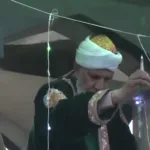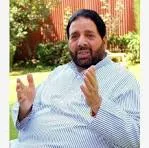Narendra Modi has submitted resignation along with his cabinet to the President, Droupadi Murmu, leading to the dissolution of the 17th Lok Sabha on 5th June Wednesday on the recommendation of the Union Cabinet. President Murmu accepted the advice of the Cabinet and asked the outgoing Prime Minister and his Council of Ministers to continue till the new government assumes the office. She accepted the resignation. There are feelers that Narendra Modi will take oath as the Prime Minister for the third consecutive time on 8th June. The moment the Lok Sabha Election Results started pouring in on Tuesday and the trends became clear by the afternoon. It ended the speculation about the seat tally and it enabled the analysts to guess political permutations and combinations as far as the formation of the 18th Lok Sabha is concerned. By evening it was clear that BJP was not going to get a simple majority on its own as was being presumed by the political watchers. Not only could that, the NDA constituents also could not enable the BJP to cross even the 300 mark. BJP had been confident of securing more than 400 seats but its ambitions did not materialise. Though BJP led NDA managed to cross the simple majority mark meant to form the new government at the centre. What added to the worries of the Narendra Modi led BJP was the appreciable gain of seats by the Congress and securing of a significant number of seats by the Congress led INDI Alliance. It kept the BJP on the tenterhooks. In the previous two terms BJP had crossed the simple majority mark on its own. But this time it failed to reach there. Political circles were abuzz with the pressure on its alliance partners by the opposition to join them. Media was flooded with information of efforts being made by the INDI Alliance to wean away NDA partners like Nitish Kumar. Even N .Chandrababu Naidu led TDP was in the news and it was given importance to improve the NDA seat tally. This political tug of war is going on. One thing is clear that this time it will not be a cake walk for the Narendra Modi led NDA to keep its alliance partners in harmony. As the independence of decision making that defined the previous Modi regimes will be missing. This time BJP will be mired in the dynamics of coalition politics that once retarded the Atal Bihari Vajpayee led regime. This will have a significant impact on the governance and the style of functioning. In order to keep the house in order Narendra Modi will have to do the balancing act. The Uttar Pradesh debacle has made a considerable impact on the image of the BJP. Opinions emerging from the ground reveal that there has been a disconnect between the masses and the elected representatives of the BJP. Not only that, certain circles are attributing the BJP defeat in UP to the intent of cutting the popularity of the incumbent Chief Minister Adityanath Yogi to the size so that his emergence in the national politics is curtailed by vested interests. As his choice of the candidates were not considered, resulting in the worst performance in the state. If this is true then certainly all is not well. BJP needs to revitalise its grassroots and reach out to the people who have managed to prepare the ground for it as a political alternative to the Congress. It is proper to mention that when BJP was formed in 1980 after dissolving the Bharatiya Jana Sangh (BJS) by adopting Gandhian Socialism and Positive Secularism in its constitution; its founder’s intent was to compete with Congress to be politically significant. It led to the disgruntlement of the original ideologues of the BJS like Prof. Balraj Madhok who never came into BJP fold accusing its leaders of ideological compromise. Leading to the loss of committed cadres of the BJS. Now the BJP can’t afford to annoy its cadres and end up like Congress. That it imitated in 1980 to indulge in competitive secularism. India needs a stable and committed government at the centre to keep India on the path of resurgence.
17th Lok Sabha Dissolved

Sign Up For Daily Newsletter
Be keep up! Get the latest breaking news delivered straight to your inbox.
By signing up, you agree to our Terms of Use and acknowledge the data practices in our Privacy Policy. You may unsubscribe at any time.
Leave a Comment Leave a Comment
Stay Connected
Latest News
Recent Posts
- JK celebrates Eid Milad-un-Nabi, People offer prayers at Dargah Hazratbal Shrine in Srinagar
- Hakeem discusses flood-related welfare issues with LG
- Political leaders greet people on Eid Milad-un-Nabi (SAW)
- Sagar reviews preparations for Sheikh Abdullah’s death anniversary
- AIP says Er Rashid narrowly escaped fatal attack inside Tihar Jail







